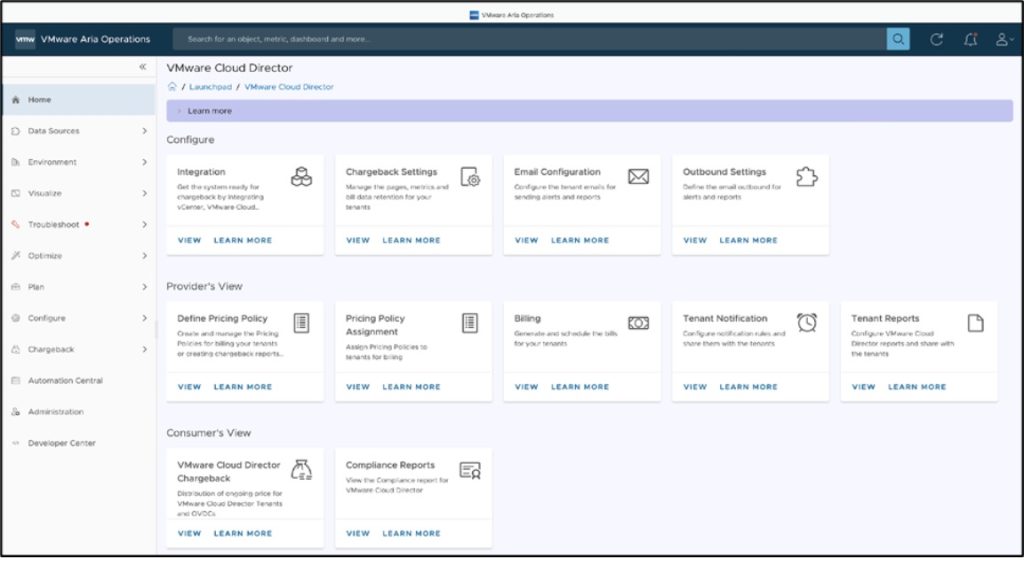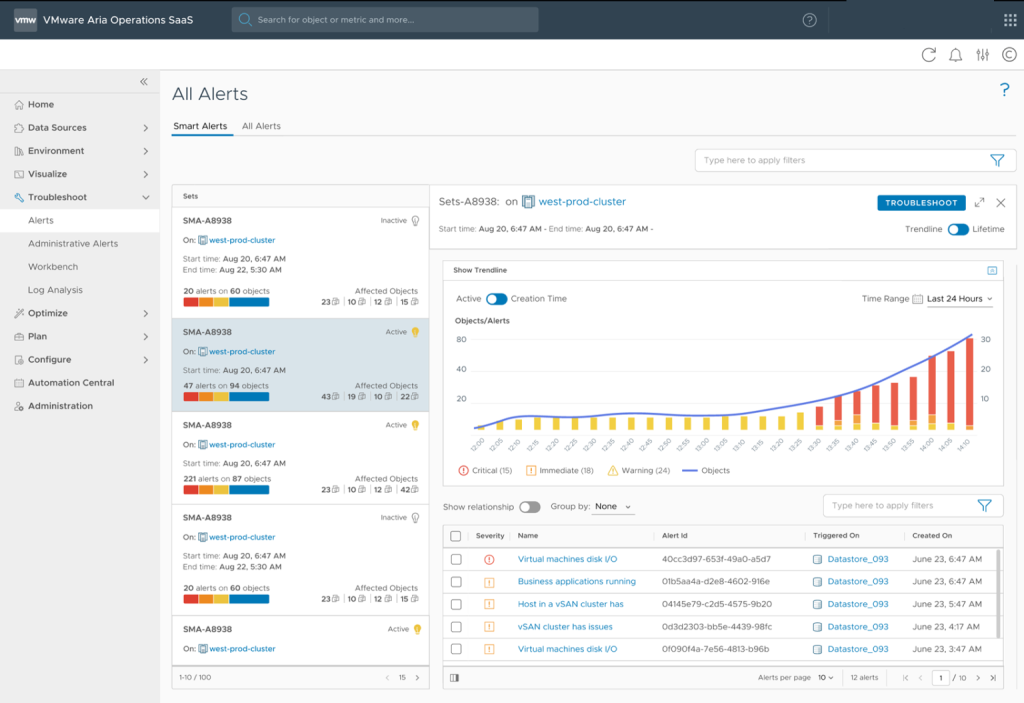We are pleased to announce the latest release for VMware Aria Operations 8.16. This release focuses on Ease of Usage and Improved performance and governance capabilities.
As recently announced VMware Aria Operations will now only be available as a part of VMware Cloud Foundation and VMware vSphere Foundation, as discussed in this recent blog: Dramatic Simplification of VMware Aria as part of VMware Cloud Foundation.
VMware Cloud Foundation is our full-stack private cloud solution that combines the scale and agility of the public cloud with the security and performance of the private cloud. VMware Aria Operations is no longer sold as a standalone product or as SaaS as discussed in this blog: VMware End Of Availability of Perpetual Licensing and SaaS Services.
Following are some of the features announced as part of the release:
Chargeback Integration into VMware Aria Operations
Chargeback formerly known as the Tenant app was a standalone product which worked in conjunction with VMware Aria operations and vCloud Director.
In this release, Chargeback has been integrated into VMware Aria Operations.
This will allow:
- Simplified tenant billing with flexible scheduling and billing at organization or virtual data center level.
- Customizable pricing configuration with support for allocation models.
- Deeper visibility of tenant network usage.
- Comprehensive self- service monitoring capabilities.
- Custom Dashboards and Reports for Providers and Tenants.

Improved Network monitoring information via LLDP
Link-Layer Discovery Protocol is the vendor neutral protocol used by non-Cisco network device vendors. VMware Aria Operations provided a limited set of information for the LLDP protocol as opposed to the CDP (Cisco Discovery Protocol). With this release the following data will be available for the LLDP protocol:
- System Description
- MTU Size
- Port Description
- Link aggregation Status for LACP configurations

Intelligent Alert Clustering

VMware Aria Operations displays unified alerts across VMware and 3rd Party products. With an increasing number of integrations that are readily available, the volume of alerts has gone up tremendously.
In order to improve the ease of consumption of these alerts, we have introduced a new feature that is called Intelligent Alert Clustering.
This feature was initially available on the VMware Aria Operations SaaS version but now has been introduced on-prem.
With the best-in-class object relationship mapping, grouping of various alerts can be done based on related objects. This will help narrow down the alerts and reduce the overall number of alerts. There is also a timeline option, where we can playback the original alert and check what triggered it, further helping to reduce the overall MTTR.
Reducing widget Sprawl to simplify dashboard experience
vSphere and vSAN Out of the Box Dashboards use only limited number of widgets and views. To deliver more capabilities while increasing usability, we have reduced this number to 17. Following is the list of widgets and views:
- List (View)
- Top-N List
- Summary Table. It’s a View
- Health Chart
- Trend Chart. It’s a View
- Distribution Chart. It’s a View
- Scoreboard
- Heat Map
- Property List
- Geo
- Relationship –> Was called Object Relationship (Advanced)
- Weekly Pattern
- Alert List
- Top Alerts
- Metric Chart
- Metric Picker
- Object List
New Metric Added for number of VMs moved via Workload Placement
In environments where there are large number of workloads, it becomes difficult to track multiple vMotions and VMs that move due to WLP. A new metricWLPVmMovedCount has been added to the cluster object level to:
- capture the number of VM migrations happening in each WLP action.
- determine the clusters involved and the time of these migrations.
Upgraded VCF compliance pack based on VCF 4.5 Audit Guide
With the latest release, users can initiate compliance assessment of VCF 4.5 environments with the latest upgraded VCF compliance pack. Users will be able to generate a non-compliance report with affected objects and misconfigurations associated with them.
Usage of Tags to exclude VMs and clusters from participating in Workload Placement
In larger environments where there are production critical workloads, there is a need for running certain VMs on specific hosts. In instances where there is a VCF upgrade, there is a need for such VMs to be excluded from WLP. In the latest release, we will be able to use Tags created in vSphere to form a Business intent to exclude VMs and Clusters from participating in the Workload Placement.
Ability to change VMware Aria Operations display language
VMware Aria Operations currently chooses the display language based on browser settings. With the latest release the user will be able to change the display language from the user preference section.
For a full list of updates, visit our Release Notes.
Also, visit us online at VMware Aria Operations and check out these additional resources.
Learn about VMware Aria Operations features on TechZone.
Discover more from VMware Cloud Foundation (VCF) Blog
Subscribe to get the latest posts sent to your email.





